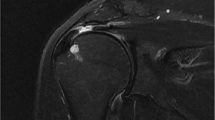Abstract
The standard procedure used to repair partial-thickness tears involves initial progression of the lesion to a full-thickness tear prior to tendon repair. However, the option for a bursal-side partial-thickness rotator cuff tear includes the preservation of as much of the remaining intact fibers as possible. Instead of inserting suture anchors in the medial row, as in the conventional suture-bridge technique, two mattress sutures are inserted into the rotator cuff. Full-thickness access is achieved using a percutaneous spinal needle and medial mattress sutures to preserve the articular bone attachment of the remnant fibers and to compress the repaired tendon on the footprint. Our method can help preserve the remnant rotator cuff tendon without tissue damage and can restore the normal rotator cuff footprint.






Similar content being viewed by others

References
Ellman H (1990) Diagnosis and treatment of incomplete rotator cuff tears. Clin Orthop Relat Res 254:64–74
Gartsman GM, Milne JC (1995) Articular surface partial-thickness rotator cuff tears. J Shoulder Elbow Surg 4:409–415
Park MC, ElAttrache NS, Ahmad CS, Tibone JE (2006) “Transosseous-equivalent” rotator cuff repair technique. Arthroscopy 22:1360.e1–1360.e5
Yoo JC, Ahn JH, Lee SH, Kim JH (2007) Arthroscopic full-layer repair of bursal-side partial-thickness rotator cuff tears: a small-window technique. Arthroscopy 23(8):903.e1–903.e4
Kim KC, Rhee KJ, Shin HD, Kim PS (2009) Arthroscopic footprint reconstruction of bursal-side delaminated rotator cuff tears using the suture-bridge technique. Knee Surg Sports Traumatol Arthrosc 17(7):840–843
Kim KC, Rhee KJ, Shin HD, Kim DK (2009) Arthroscopic transtendon suture-bridge technique for concurrent articular- and bursal-side partial-thickness rotator cuff tears. Knee Surg Sports Traumatol Arthrosc. June 16 [Epub ahead of print]
Matava MJ, Purcell DB, Rudzki JR (2005) Partial-thickness rotator cuff tears. Am J Sports Med 33(9):1405–1417
Lo IK, Burkhart SS (2004) Transtendon arthroscopic repair of partial-thickness, articular surface tears of the rotator cuff. Arthroscopy 20(2):214–220
Burkhart SS (2004) The principle of margin convergence in rotator cuff repair as a means of strain reduction at the tear margin. Ann Biomed Eng 3:166–170
Weber SC (1999) Arthroscopic debridement and acromioplasty versus mini-open repair in the treatment of significant partial-thickness rotator cuff tears. Arthroscopy 15:126–131
Wolff AB, Magit DP, Miller SR, Wyman J, Sethi PM (2006) Arthroscopic fixation of bursal-sided rotator cuff tears. Arthroscopy 22(11):1247.e1–1247.e4
Brady PC, Arrigoni P, Burkhart SS (2006) Evaluation of residual rotator cuff defects after in vivo single-versus double-row rotator cuff repairs. Arthroscopy 22:1070–1075
Author information
Authors and Affiliations
Corresponding author
Rights and permissions
About this article
Cite this article
Kim, K.C., Rhee, K.J., Shin, H.D. et al. Mattress suture-bridge technique for bursal-side partial-thickness rotator cuff tears. Arch Orthop Trauma Surg 130, 407–411 (2010). https://doi.org/10.1007/s00402-009-0996-4
Received:
Published:
Issue Date:
DOI: https://doi.org/10.1007/s00402-009-0996-4



